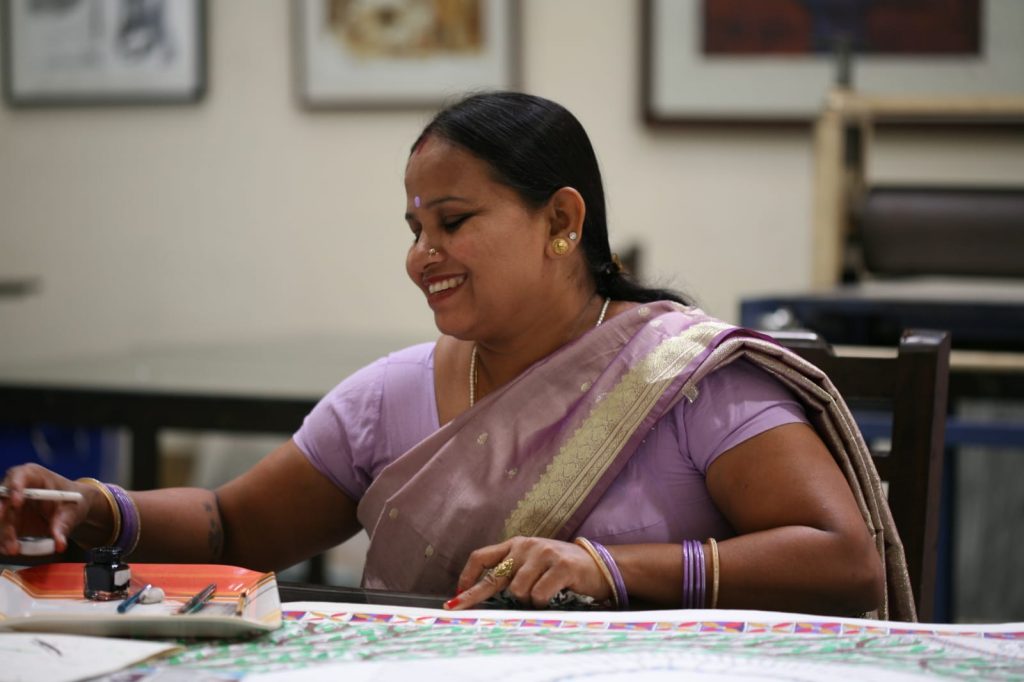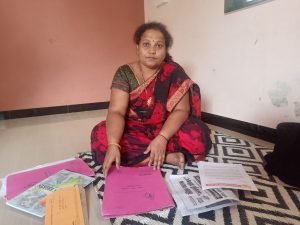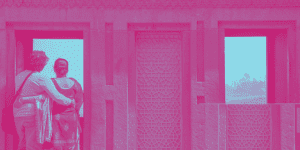Godna: The Resistance Art Form Of Madhubani’s Dalit Dusadh Women
Godna, the fine art of tattoo painting, is practised by Dalit Dusadh women. Its approach, raw material, and themes are nothing like the more popular Mithila artwork

“Ee dharauni haye, dharne rahab (this is our legacy, keep this with you).” For me, these words of Vinita Devi, a Godna artist from Madhubani district of Bihar, hold many layers of meaning and importance.
I met Vinita Devi in Jitwarpur village where I went as a 21-year-old researcher for my Masters dissertation in 2020 on the art of the Dalit Dusadh women who are skilled in Godna painting. The Dusadh community traditionally performed the role of watchmen.
Godna art is distinct from the better-known Mithila, or more accurately Madhubani, style which mostly features Hindu deities in vibrant colours and is traditionally done by the Brahmin women of this region. Godna (meaning ritual tattoo art) paintings are distinctly different – they are mostly black and white, and crafted by Dalit Dusadh women of the area. The themes centre around nature, daily lives of the community or Dalit deities.
The day I met her, Vinita Devi was giving finishing touches to a painting of Salhesh, a local deity of the Dalit Dusadh community of Bihar. Godna is done on handmade paper crafted from gobar (cow dung) though traditionally this art was created on walls and ceilings of homes.

This quest is both personal and academic for me. A daughter of Godna artists, I grew up in Delhi, surrounded by the art form but oblivious to my own identity as a Dalit Dusadh. My mother often says this is the result of the privilege I accumulated due to the struggles and sacrifices she and my father made. When I ask my mother Lalita Devi, a state awardee, why she had tattoos all over her body and I did not, she would say: “This is your privilege that you did not have to get the tattoos.”
Historical evidence shows that the British marked prisoners with tattoos to identify them as criminals, creating a stigma around the Godna. “Besides its prevalence as a cultural practice, tattooing was also used as a method of torture by the state. In fact the word used for tattooing, ‘godna’ (to prick, puncture, dot or mark) came to mean the marking of prisoners during the British Raj (Anderson, 2000). The prisoners’ foreheads were tattooed as a method of identification. Criminals were branded or tattooed, often with the word “thug” on their forehead. The tattoo marks led to much social stigma of the convicts on parole, as they were easily identifiable by their tattoo marks in the public,” says Ambedkar University researcher Sarah Haq in her paper, ‘The Skin and the Ink: Tracing the Boundaries of Tattoo Art in India.’
My Baba and Maa had always wanted me to write about this art form and our community that practised this art. In popular media, culture and writings, Godna has always been erased and even more invisible are the Dalit Dusadh women who are skilled in this art form. Historians and academics writing about Godna describe their art as “Harijan paintings”, which is both derogatory and a misrepresentation. Often, the women have been referred to as “local artists”, completely erasing the Dusadh identity and the origins of a distinct art as a form of resistance against the Brahminical provenance and practice of Mithila paintings.
So, when Vinita Devi asked me to “hold the legacy”, what she meant was for us as a community to document our own history and give the women artists their due place in it.
Origin Story
Jitwarpur is the centre of Godna painting. According to the oral narratives of its artists, the art form originated sometime in the 1970s when two women, Zahida and Channo Devi, started painting in the tattoo form on paper/canvas. Traditionally, this art was mostly done on walls during festivals and/or any other celebrations.
Zahida, a Natin (the tribal community which used to do tattoos all over the body), taught the art to Channo Devi, who then introduced it to the other women of Jitwarpur. Channo Devi insisted that women learn this art to become independent, said Reena Devi, a Godna artist. Theres is also local song about the art and its association with Natin community:
Utarhi raj san ele ek nataniya re jaan
Re raj san ele ek nataniya re jaan
Re Jaan baisire gele kadam birichiye re jaan
[From northern states, one Natin/nomadic woman came, and she sat under a Kadam tree,winds were blowing, and it was raining cold]

Dusadh women have used Godna to assert their community identity and art form. The more popular Mithila paintings are centred on the life stories of Rama, Sita and other Hindu gods, but other styles have existed alongside it. Godna is one such.
Traditionally, Mithila paintings had been practised on the walls and floors of homes and they were “discovered” as a distinct art form only in the 1930s. Support to put this art to commercial use came after the 1966 and 1968 droughts came from the government, especially the All India Handicrafts Board. Women were encouraged to transfer the motifs of the murals onto paper. The art form became hugely popular, especially as home decor. The art was primarily dominated by the upper caste Brahmin men and women.
Dalit Dusadh women were left out of government patronage, and also largely prohibited from drawing images of Rama, Sita, other gods of Savarna culture and Kohbar (wall paintings with symbols of marital harmony and fertility). This erasure can be seen in contemporary times, when during the beautification of the Madhubani railway station, Mithila art found space but not Godna.
Godna art is rooted in the spartan, everyday lives of the Dalit Dusadh women. They first craft handmade sheets of cloth or paper, and then wash these with a mix of gobar (cow dung), gond (glue) and water. For colours, they use dye extracts from flowers, leaves and kajal or kohl. I remember my Maa used to bring gobar and gond/glue from the market and apply them on the sheets. I used to be repelled by the smell but she always asserted that this is us, our identity and culture.
“Gobar is important for us. It is my whole life. I used it to paint the walls of our jhuggis, and me and your Nani used it to make aghan (fuel) for the kitchen,” she would tell me.
As opposed to upper caste depictions, Godna art is about daily life, work, struggle, faith, culture and nature. The art style uses resources that are minimal and everyday – gobar, kajal and bamboo sticks to draw paintings/outlines, for instance. Some initial paintings also showed people carrying dead bodies of humans and animals, work which was and continues to be stigmatised and the people/community.
After Mithila paintings became well-known, certain types and styles were popularised more. This included Bharni, or filling in of colours, in paintings of Rama and Sita; Kachni or line paintings; and Tantric paintings portraying deities such as Durga, Vishu and his 10 avatars (forms) and so on.
Casteism and Erasure
I had been visiting Koilakh, my ancestral village, since I was a child. But when I first visited it as a researcher, I noticed the existence of Paswan Tola, a colony of 7-8 houses on the margins of the village, where all the Dalit Dusadhs who practised Godna art lived. This tola (settlement) was separate from the Brahmin Tola. I then started looking at my community with a new kind of consciousness and connection that political scientist Gopal Guru talked of in his essay, Dalits from Margin to Margin. He had pointed out that “the very location of the Dalit became an object of contempt and contamination by the urban base of a caste elite. This location is also stigmatised as they are segregated on the principle of purity and pollution”.
Usha, an artist, told me that casteist practices are deeply entrenched in her region. “The caste system is very much prevalent in our village society. We cannot enter the Brahmin’s ritual spaces; we cannot touch their worship goods. We are always seen as disguised,” she said.
Godna art is rooted in the very experience of casteism, and of segregation of spaces and indeed, of gods. Women artistes of Jitwarpur village said that the upper-caste Brahmins would say: “Ram and Sita are our Gods. You cannot sell their paintings, go and make your gods.”
“They used to scare us – say that we would be struck by misfortune if we painted their gods. There was fear of life among us, so we started making our Godna paintings,” said the women artists of Jitwarpur village. Women were also prevented from painting some of the sub forms of Mithila paintings. Sunita Devi, a local artist shared that they were told that Tantric paintings could only be drawn by certain people from upper caste with “magical powers”.
“Since then, we started our own version of the Godna art. We shifted from drawing motifs from nature and our daily lives to painting our local deities like Salhesha, Chauharmal, Rahu and others,” says Sunita Devi, a local artist.
This assertiveness has brought new found fame as well as dignity to the lives of the Dusadh women artists. It has also meant that this art is beginning to be appropriated by those from outside the Dusadh community. “Now that our paintings are selling, untouchability and casteism do not matter. They started making our Godna painting. This is all hoax, hypocrisy,” said Vimla Devi who worked in Ranti village in Madhubani with a larger group of Dusadh local women artists.
The Dusadh women, when given the opportunity to showcase their art in international platforms, saw they were discriminated against because of their caste location. They allege that they were often labelled as dayan (witches). Some artists alleged that they faced casteist slurs even on international platforms.
Women Paint, Men Trade
Godna thrives on the artistry and labour of Dusadh women but it is the men who control the trade and the market. Accompanying my mother to spaces like Dilli Haat, Surajkund, Pragati Maidan, I always saw men running Godna art stalls and negotiating sales with customers. Even when women are present in the stalls, they remain at the back. My Maa was perhaps the only woman who stood at the front. This was my first glimpse into patriarchy within the community and the art form. The erasure of women was a facet I wanted to explore more deeply during my research.
Usha Devi summed up the views of most women artists who spoke to me: “Why should I engage in market activities when my husband is there?” I discovered that while women laboured over the art, they had no ownership of it or the money that accrued from sales. They had no voice in decision-making processes or activities in the supply chain — pricing, sales, stalls and so on. I remember a conversation I had with my Maa on this.
“Can they create colours like us? No, they can’t. Can they use cow dung on paper? No, they can’t. Can they make kajal? No, they can’t. Can they struggle as much as we do? No, they can’t. They can only pretend that they are artists,” she said indignantly.
Women also mention the hierarchy within the Dusadh community — a class within the caste, so to speak. Families of artists with more power and resources exploit women artists who are not that well off. “They are just like the Brahmins, practising the same kind of discrimination and exclusion,” said Meena Devi, an artist.
“The so-called award winners and more powerful women of our own community, along with their sons and husbands, buy paintings from us and other local artists who don’t have access to urban markets. We have no resources, name or brand. They use their resources and capital to set up stalls hence their art is visible on big platforms, markets and offices. We never get the chance to show up in the market,” said another woman artist who wished to remain anonymous.
Some women allege that the paintings that were bought from them went on to win awards. Sita Devi is one such artist whose art won an award while she struggles to make ends meet. “They have the praise, we are garib (poor). We just want food. What we will do with name fame. We just made paintings, a maximum of Rs 1000. There were some instances where I got to see my paintings in that award list. I am just happy to know that my art got an award,” she says.
Women who have won awards are unaware of the exact amount of pension they are entitled to. The Covid-19 pandemic hit rural Dusadh artists very hard, especially single women, who have had to do hard labour to sustain themselves and their families. “I even had to work on construction sites, my family was destroyed, I lost my husband, my children dropped out from school. All this is a burden on me,” says a woman artist who is a state awardee herself and also the wife of a national awardee who died during the pandemic.
Our Newsletter
Subscribe to Our Newsletter
We believe everyone deserves equal access to accurate news. Support from our readers enables us to keep our journalism open and free for everyone, all over the world.



